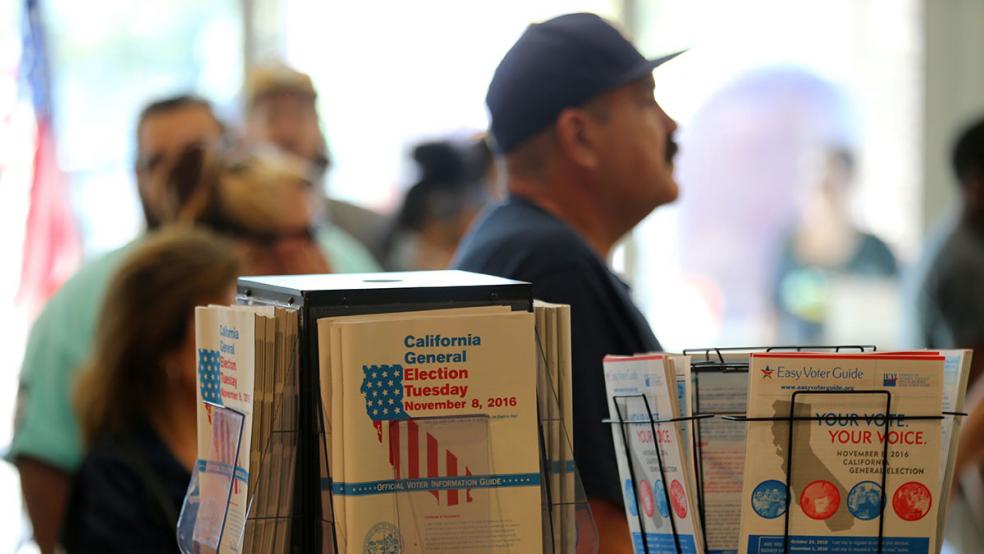Last week, the second-place finisher in the presidential election won the White House, for the fifth time in 58 tries. One obvious response is that the undemocratic Electoral College massively distorts voter preferences and should be abolished. I agree; I’ve supported the National Popular Vote for many years, a state compact that would make the candidate with the most support president every time. But Lady Gaga’s efforts notwithstanding, reforms to the Electoral College are unlikely, simply because it got Donald Trump elected, and his party controls legislating in Congress and most states.
So we should try to understand how this deviation occurred between the will of the people and the outcome of the election. While there are many theories, one doesn’t get discussed enough in our political or cultural debates. It’s known as regional inequality.
Related: Is the Country on the Wrong Track? Why That's a Stupid Question
This election was a unique event, even among Electoral College catastrophes. In 1824, Andrew Jackson led John Quincy Adams in both the popular vote and Electoral College; a “corrupt bargain” installed Adams because neither candidate won a majority of electoral votes. In 1876 and 2000, the Electoral College margin was razor thin and contested through recounts.
Even 1888, an election with a seemingly wide disparity between the Electoral College and the popular vote, wasn’t that far off. Benjamin Harrison won New York’s 36 electoral votes and Indiana’s 15 electoral votes by less than 1 percent as part of a 233-168 victory (even though Grover Cleveland received 94,350 more popular votes out of 11.3 million cast). Moving 7,500 New York votes from Harrison to Cleveland would have given the Democrat the win.
This year’s margins were bigger. As of this weekend, Hillary Clinton has collected 630,000 more votes than Trump, but lost the Electoral College in a relative landslide (Michigan and New Hampshire have not been called, but if they follow current trends, Trump will win 306-232). With millions more votes to be counted, a majority of them in coastal states Clinton won, the popular vote lead is likely to grow, and the difference made even larger.
Related: So You Voted — Now Here’s How You Really Change America
Trump relied on a series of razor-thin victories in large Rust Belt states — Michigan, Wisconsin, Pennsylvania — all of which had margins of around 1 percent. He also engineered Republican pickups in Ohio and Iowa, and almost took Minnesota. This regional strength accounts for the Electoral College/popular vote split.
You could explain this with an 1888-style racial theory. Back then, Grover Cleveland won almost all his electoral votes in the solid Democratic South, an expected consequence shortly after the Civil War and Reconstruction. Similarly, last week whiter Midwest counties broke for a candidate who demonized various ethnicities and attracted white supremacists. Or you can explain Trump’s win by looking at distressed factory towns with scant opportunity that swung to him.
But regional inequality actually combines both theories. As Phillip Longman described last year in a brilliant article, since the 1980s, a few areas have been pulling away from their counterparts. Places like Washington, New York City, San Francisco and Los Angeles have generated much higher incomes per capita than everyone else. Not only do most large U.S. corporations call these cities home, but it’s also where most economic dynamism takes place.
Related: 4 Reasons Trump’s Economic Policies Would Be a Disaster
Younger firms (around for less than five years) have been consistently in decline since the 1980s. A wave of mergers put corporations that were once pillars of Midwest communities under the control of big conglomerates on the coasts. Banks are dominated by a few mega-corporations instead of locally controlled. Chain stores far outnumber small, local retail businesses. Successful high-tech firms, driven by patent monopolies, cluster in a few hubs that have the talent needed for their staffs. Venture capital-funded startups, a remaining source of innovation, are heavily concentrated in big cities; over three-quarters are located in one of the nation’s 10 largest metro areas. One reason: Young entrepreneurs want to be close to the mega-firms that might eventually buy them out.
Through market concentration, money flows from one area of the country to the other. We see that in statistics showing that inequality between firms has soared; the victors are getting all the spoils, and they all live together.
Low geographic mobility means that populations lag behind in flowing to where these new jobs are located. So Michigan and Pennsylvania and Ohio retain most of their electoral votes, but for most residents the wealth has evaporated. Service-sector workers there have jobs, but the real profits go elsewhere, to executives and investors.
Related: Five Things Trump Wants to Do That Liberals Would Love
Because of this, not everyone in the country experiences the economy the same way. You can throw out statistics showing aggregate gains in income and employment, but they are much more strongly felt in the few regions doing well than the ones falling behind. Indeed, Clinton did well where the economy is prospering and the legacy of the Obama economy is strong, while Trump gained in areas with weaker job growth and lower average earnings, and where jobs are under the greatest threat of outsourcing.
These wealthy metro regions are strongly correlated with multiculturalism, also a function of regional inequality. An economically booming area with available jobs is simply more attractive to a recent immigrant. Whiter regions in decay, without proximity to many immigrants, have angry residents willing to believe that the help their areas need flows instead to undocumented workers. It’s not true, but it’s a salve in a time of despair. Witness the strength of Trump’s support in areas that have the fewest undocumented workers. Racism can flourish in towns in decay.
Thirty-five years of utter failure to rein in concentrated corporate power has created a few winners and lots of losers, and left communities on the outside desperate to vote for any help, whether that message comes from the left or the right. These trends have simmered since 1980, and the Great Recession confirmed them. It’s not just economics; these regions feel powerless and forgotten socially because monopolies are in control. Until we get more regional balance to our economy and our culture, the Electoral College will always shift toward the change agent, regardless of who more Americans vote for.
Related: Tough Reality Check for Trump's Pledge of Better Heartland Jobs
Having pinpointed the problem, it’s obviously much harder to fix. Like everything else, Trump hasn’t fully explained his antitrust policy. He promised to block the AT&T/Time Warner merger and investigate Amazon, but that was likely tied up in personal animus for the press (Time Warner owns CNN, and Amazon CEO Jeff Bezos owns The Washington Post). And the legion of conservative lobbyists running Trump’s transition may have no problem with further consolidation. His top hire on tech policy used to work for Verizon, the telecom giant.
If Trump wanted to follow through on restoring the industrial Midwest, he’d probably have to break the monopoly power concentrated on the coasts. Over time that would smooth economic performance across the country and make depressed areas more hospitable to everyone regardless of race. So keeping that promise might actually make impossible the likelihood that a Trump could ever win the Electoral College again.






